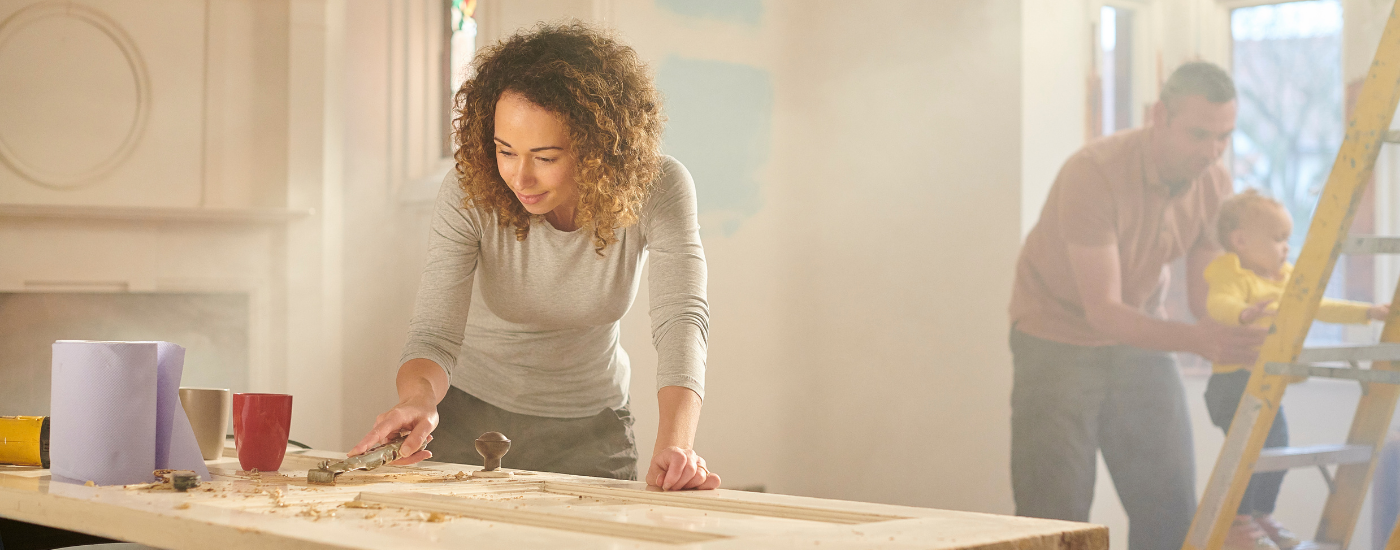When you’re in the market for a new home, it can be tempting to imagine transforming a low-cost fixer-upper into the home of your dreams. After all, the price is right, and the possibilities are endless. But as many a homeowner can tell you, turning an ugly duckling property into a beautiful swan takes work.
To help avoid a potentially frustrating decision-making process, unexpected headaches and a lot of money juggling, preparation is key. In some ways, buying a fixer-upper is much like buying any other house—you'll still need to account for all the standard homebuying expenses like a down payment, closing costs and home inspections. But if the house needs work, you’ll also need to budget for the cost of home improvement.
If you’re committed to making your renovation work, it's essential to plan ahead, secure a trustworthy contracting team and work with them to set a realistic timeline that fits your budget. Here are our best tips to help you buy the fixer-upper of your dreams.
Location, location, location
The only thing you can’t change about a house is its location. So when shopping for a fixer-upper, think carefully about the neighborhoods you want to live in, including their crime stats, amenities, school zones, shops, restaurants and parks. Are there more houses that you would consider fixer-uppers than not? Is your fixer-upper located close to a high-traffic or noisy areas like a railroad crossing or bus depot? Look for houses in appealing or up-and-coming neighborhoods. Scrutinize the condition of the surrounding homes. Do they look well-cared-for and occupied?
Vet your contractors
Sometimes TV can make us think that remodeling a home is as easy as buying a cheap fixer-upper and hiring the lowest-bidding architect or contractor. But please don't. It's too risky to choose a contractor simply because they’re the most inexpensive, especially with an older home.
You can create the home you want in a desirable neighborhood as long as you maintain control over the process. So as you start planning your project, be prepared to wait for the right contractor and understand that there should be no ambiguity in the scope of work when you are shopping around for your contractor. You want someone who can customize the house to your exact needs and plan your whole house remodel from blueprints to the final presentation.
Never hire or keep a contractor who seems disinterested when they are communicating with you. Be sure your contractor cares about your remodeling project. If they don't seem that bothered about it, thank them for their time and walk away. It's also important to be on the lookout for home repair scams, where bad actors con homeowners out of quality work.
Keep the lines of communication open
Communication is key throughout this entire process. This includes connecting with anyone else who is making decisions about the home (like a spouse or partner), your home insurance agency (to keep them abreast of the changes and ensure your home has adequate coverage at all times) and especially your contractor.
When you’re speaking to your contractor, be as detailed as possible. The more details your contractor has, the smoother the project will go. Establish communication guidelines early by asking if you can send text messages, how easily they are reached by cell phone and what a suitable reply time is. Set your expectations by communicating with your contractor each day before any work starts. Use this time to ask questions or to mention any concerns you may have.
Make a budget...then add 20%
Be clear from the get-go about what you can afford. Homeowners sometimes shy away from sharing their exact budgets, thinking it may increase the overall cost, but in fact, the opposite is true. If your contractor knows your budget, they better understand where you stand regarding your overall plans and can work within the cost constraints. They can also better advise you through the process for the best results.
When you receive your initial estimate, take your time and go through it with a fine-tooth comb. Ask as many questions as you can to ensure nothing is misunderstood or misleading. And make sure you let your contractor know that you don't want to include an allowance in their estimate. An "allowance" is a mystery line item in an initial bid for items that haven’t been determined yet. The key to side-stepping this is to be precise about exactly what you will require before your contractor works up a detailed scope of work.
While you shouldn’t expect your contractor to go over budget, consider the extra 20% a rainy day fund. We all saw Money Pit, right? Things happen. If an emergency arises, you want to be prepared for it.
Get organized
Prioritize the larger projects before moving in (like painting, replacing plumbing or upgrading the electrical) and make your way through your master renovation to-do list.
The best way to keep track of tasks during a home renovation is by maintaining an organized home renovation binder. Some people prefer to save documents and spreadsheets on their computer or their favorite reno app, but you can make an old-school binder, too. Whatever option you choose, make sure to include:
- Floor plans with elevation details
- Room sketches
- Overview of your project plans
- Contractor estimates
- Exterior landscape architect plans
- Design inspiration photos
- Contracts and proposals from contractors and subcontractors
- A list of vendor contacts
- Information about special rules like city regulations or historic district rules
- Permits
- Manuals and warranties
- Paint samples
- Fabric samples
- Budget details
- Room by room to-do lists (differentiate what will have to be done professionally and what can be DIY)
Make a timeline, but plan for delays
While most renovations seem to take 30 minutes on HGTV, it's vital to set realistic expectations about a timeline when renovating your fixer-upper. Collaborate closely with your contracting team to understand your timeline—while the construction process will have some fluidity, it should never be a mystery.
Ask for your timeline broken down by project. You need to know when the project is expected to begin and be completed. This timeline should include time estimates of the various in-between steps explained.
Besides a renovation binder, consider keeping a project journal. Whether you keep notes on your phone or handwrite them into an actual notebook, it's an excellent place to track the project timeline, delivery dates and daily progress. It's also the perfect place to jot down questions that crop up during the day so you can remember them for your next daily check-in with your foreman.
Protection through inspection
What if you don't know what kind of projects you may need to do in your fixer-upper? Consider a specialized inspection. General home inspections are important, but whole-home inspectors can only look so far. When purchasing a fixer-upper, the cost of additional inspections is negligible when compared to unexpected issues that can end up costing a lot in the long run.
- Engineering inspection: A certified structural engineer will probe the foundation and the soundness of all support systems.
- Roof inspection: A roof inspection will uncover if you have any leaks, rust, rot or cracks in the roofing material.
- Pest inspection: A pest control specialist will examine the house for existing and potential pest damage.
- Sewer inspection: A certified plumbing professional will uncover any leaks or cracks in the plumbing and determine your septic system's health.
- Electrical inspection: Professional electricians can identify any safety issues or electrical deficiencies in your fixer-upper as well as provide tips on future maintenance and preservation of your older home.
- Pool inspection: If necessary, bring in a proper inspector to assess all pool and/or hot tub systems and surfaces.
Plan for permits
The permit process for construction projects can be complicated, as it depends on the project's scope and where you live. Fortunately, your contractor is just the expert you need to assist you with this task. Make sure to ask your contractor and/or architect who will handle the permits and how you can be best involved.
Know where you are willing to compromise
Prioritize your needs. First, remodel your must-haves, then worry about your maybes. With a fixer-upper, it may be tempting to do everything immediately because it can feel like it all needs to be done, but starting with critical projects can also give you a better idea of what you could do without. For example, your heart may be set on a farmhouse sink, but after you start your kitchen with the intention of saving the existing cabinets, you may change your mind if the sink requires a cutout.
Don't skimp on materials you want to last for years
When choosing materials and finishes with your contractors, don’t just pick the least expensive options because of their price point. If you expect to live with the remodel for a while, always choose the highest-quality material that fits your budget.
Similarly, you don't want to skimp on quantity. Even when buying your own DIY supplies, always include a buffer for mismeasurement and breakage. Not only is it a hassle to return to the store, but you could also end up with a mismatched lot color—or worse, your item could be discontinued. The best practice is to overbuy, especially if the supplier has a good return policy.
Tackle projects simultaneously
If you are planning to take on multiple projects, try to complete some at the same time. Working in multiple rooms simultaneously will be the best use of time for everyone involved. Work with your contractor closely to determine the best strategy, like allowing the flooring to be installed in one room while painting or replacing windows in another.
While there’s no such thing as a perfect fixer-upper (that’s sort of the point, right?), it’s important to find the fixer-upper that's right for you, your budget and your lifestyle. Just be realistic before taking the leap. Fixing up an old house isn’t for everyone, but it can be a very rewarding experience if you plan ahead.
This article is for informational purposes only and was compiled from sources not affiliated with Hippo. While we believe this information to be reliable, we do not guarantee its accuracy or completeness. The maintenance tips provided reflect general homeowner guidelines and are not professional advice. For any insurance-related decision, please consult your licensed insurance producer.




